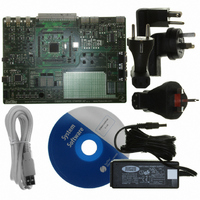EVB9S12XEP100 Freescale Semiconductor, EVB9S12XEP100 Datasheet - Page 704

EVB9S12XEP100
Manufacturer Part Number
EVB9S12XEP100
Description
BOARD EVAL FOR MC9S12XEP100
Manufacturer
Freescale Semiconductor
Type
MCUr
Datasheet
1.EVB9S12XEP100.pdf
(1328 pages)
Specifications of EVB9S12XEP100
Contents
Module and Misc Hardware
Processor To Be Evaluated
MC9S12XEP100
Data Bus Width
16 bit
Interface Type
RS-232
Silicon Manufacturer
Freescale
Core Architecture
S12
Core Sub-architecture
S12
Silicon Core Number
MC9S12
Silicon Family Name
S12XE
Rohs Compliant
Yes
For Use With/related Products
MC9S12XEP100
Lead Free Status / RoHS Status
Lead free / RoHS Compliant
- Current page: 704 of 1328
- Download datasheet (9Mb)
Chapter 19 Pulse-Width Modulator (S12PWM8B8CV1)
There are three control bits for concatenation, each of which is used to concatenate a pair of PWM
channels into one 16-bit channel. When channels 6 and 7are concatenated, channel 6 registers become the
high order bytes of the double byte channel. When channels 4 and 5 are concatenated, channel 4 registers
become the high order bytes of the double byte channel. When channels 2 and 3 are concatenated, channel
2 registers become the high order bytes of the double byte channel. When channels 0 and 1 are
concatenated, channel 0 registers become the high order bytes of the double byte channel.
See
Function.
704
Because of an order from the United States International Trade Commission, BGA-packaged product lines and partnumbers
CON67
CON45
CON23
CON01
indicated here currently are not available from Freescale for import or sale in the United States prior to September 2010
Section 19.4.2.7, “PWM 16-Bit Functions”
Field
7
6
5
4
Concatenate Channels 6 and 7
0 Channels 6 and 7 are separate 8-bit PWMs.
1 Channels 6 and 7 are concatenated to create one 16-bit PWM channel. Channel 6 becomes the high order
Concatenate Channels 4 and 5
0 Channels 4 and 5 are separate 8-bit PWMs.
1 Channels 4 and 5 are concatenated to create one 16-bit PWM channel. Channel 4 becomes the high order
Concatenate Channels 2 and 3
0 Channels 2 and 3 are separate 8-bit PWMs.
1 Channels 2 and 3 are concatenated to create one 16-bit PWM channel. Channel 2 becomes the high order
Concatenate Channels 0 and 1
0 Channels 0 and 1 are separate 8-bit PWMs.
1 Channels 0 and 1 are concatenated to create one 16-bit PWM channel. Channel 0 becomes the high order
Change these bits only when both corresponding channels are disabled.
byte and channel 7 becomes the low order byte. Channel 7 output pin is used as the output for this 16-bit
PWM (bit 7 of port PWMP). Channel 7 clock select control-bit determines the clock source, channel 7 polarity
bit determines the polarity, channel 7 enable bit enables the output and channel 7 center aligned enable bit
determines the output mode.
byte and channel 5 becomes the low order byte. Channel 5 output pin is used as the output for this 16-bit
PWM (bit 5 of port PWMP). Channel 5 clock select control-bit determines the clock source, channel 5 polarity
bit determines the polarity, channel 5 enable bit enables the output and channel 5 center aligned enable bit
determines the output mode.
byte and channel 3 becomes the low order byte. Channel 3 output pin is used as the output for this 16-bit
PWM (bit 3 of port PWMP). Channel 3 clock select control-bit determines the clock source, channel 3 polarity
bit determines the polarity, channel 3 enable bit enables the output and channel 3 center aligned enable bit
determines the output mode.
byte and channel 1 becomes the low order byte. Channel 1 output pin is used as the output for this 16-bit
PWM (bit 1 of port PWMP). Channel 1 clock select control-bit determines the clock source, channel 1 polarity
bit determines the polarity, channel 1 enable bit enables the output and channel 1 center aligned enable bit
determines the output mode.
MC9S12XE-Family Reference Manual , Rev. 1.23
for a more detailed description of the concatenation PWM
NOTE
Description
Freescale Semiconductor
Related parts for EVB9S12XEP100
Image
Part Number
Description
Manufacturer
Datasheet
Request
R
Part Number:
Description:
Manufacturer:
Freescale Semiconductor, Inc
Datasheet:
Part Number:
Description:
Manufacturer:
Freescale Semiconductor, Inc
Datasheet:
Part Number:
Description:
Manufacturer:
Freescale Semiconductor, Inc
Datasheet:
Part Number:
Description:
Manufacturer:
Freescale Semiconductor, Inc
Datasheet:
Part Number:
Description:
Manufacturer:
Freescale Semiconductor, Inc
Datasheet:
Part Number:
Description:
Manufacturer:
Freescale Semiconductor, Inc
Datasheet:
Part Number:
Description:
Manufacturer:
Freescale Semiconductor, Inc
Datasheet:
Part Number:
Description:
Manufacturer:
Freescale Semiconductor, Inc
Datasheet:
Part Number:
Description:
Manufacturer:
Freescale Semiconductor, Inc
Datasheet:
Part Number:
Description:
Manufacturer:
Freescale Semiconductor, Inc
Datasheet:
Part Number:
Description:
Manufacturer:
Freescale Semiconductor, Inc
Datasheet:
Part Number:
Description:
Manufacturer:
Freescale Semiconductor, Inc
Datasheet:
Part Number:
Description:
Manufacturer:
Freescale Semiconductor, Inc
Datasheet:
Part Number:
Description:
Manufacturer:
Freescale Semiconductor, Inc
Datasheet:
Part Number:
Description:
Manufacturer:
Freescale Semiconductor, Inc
Datasheet:










